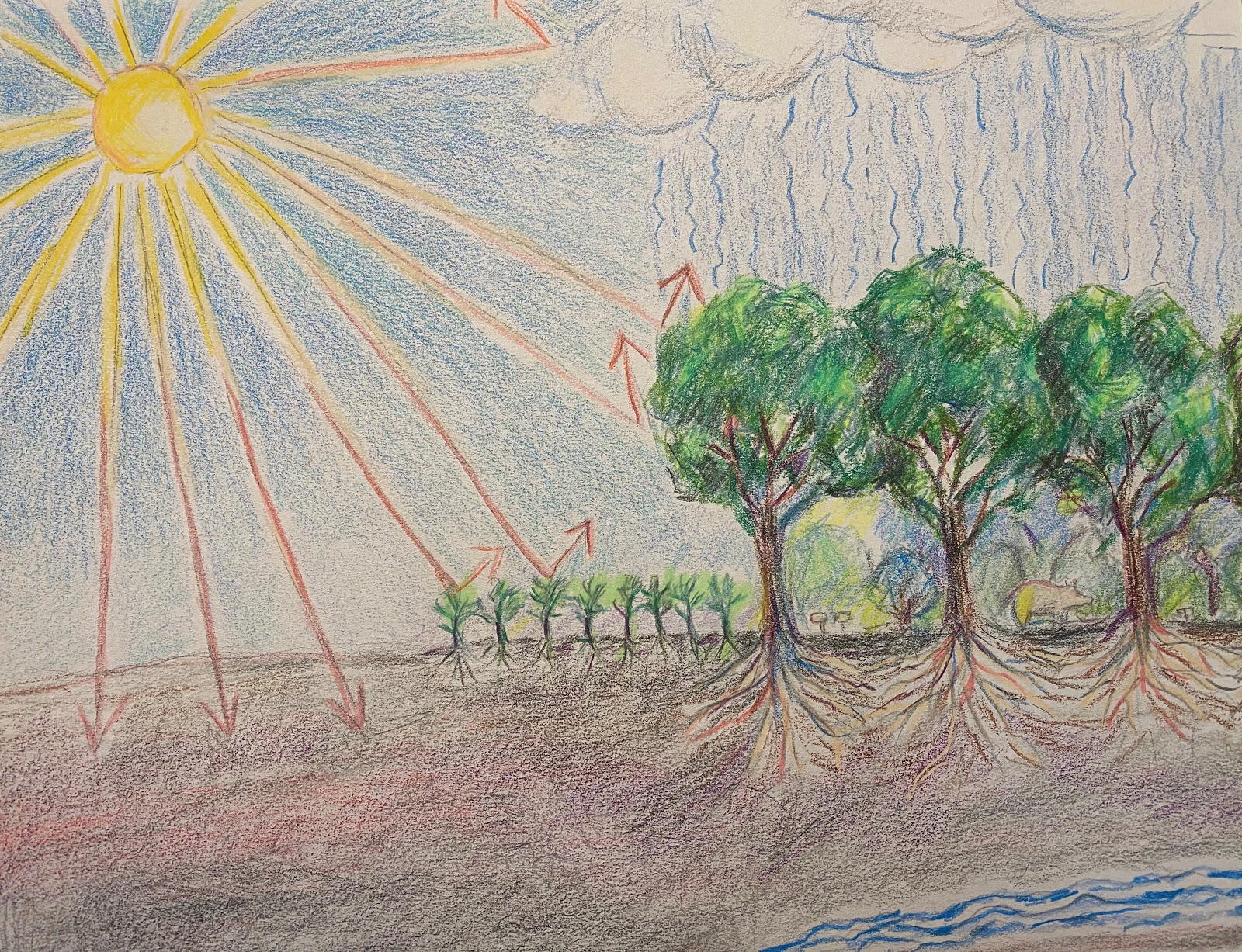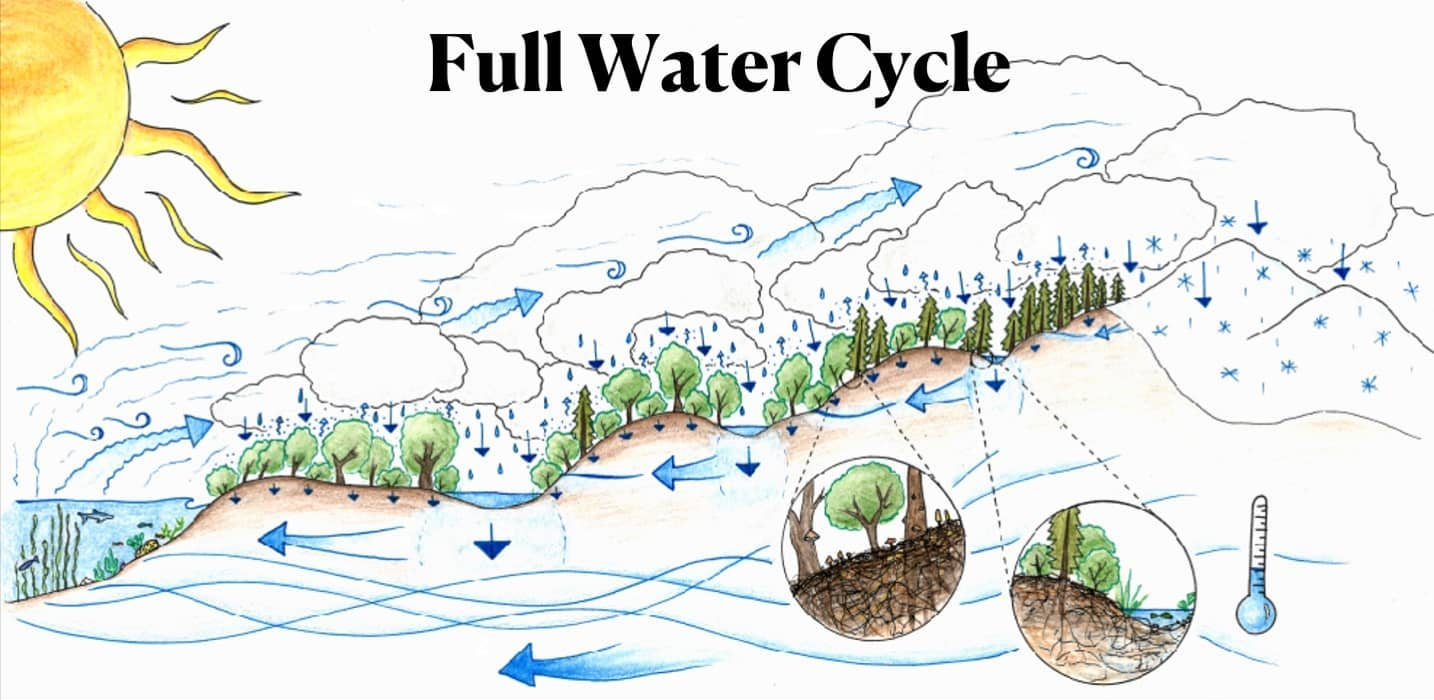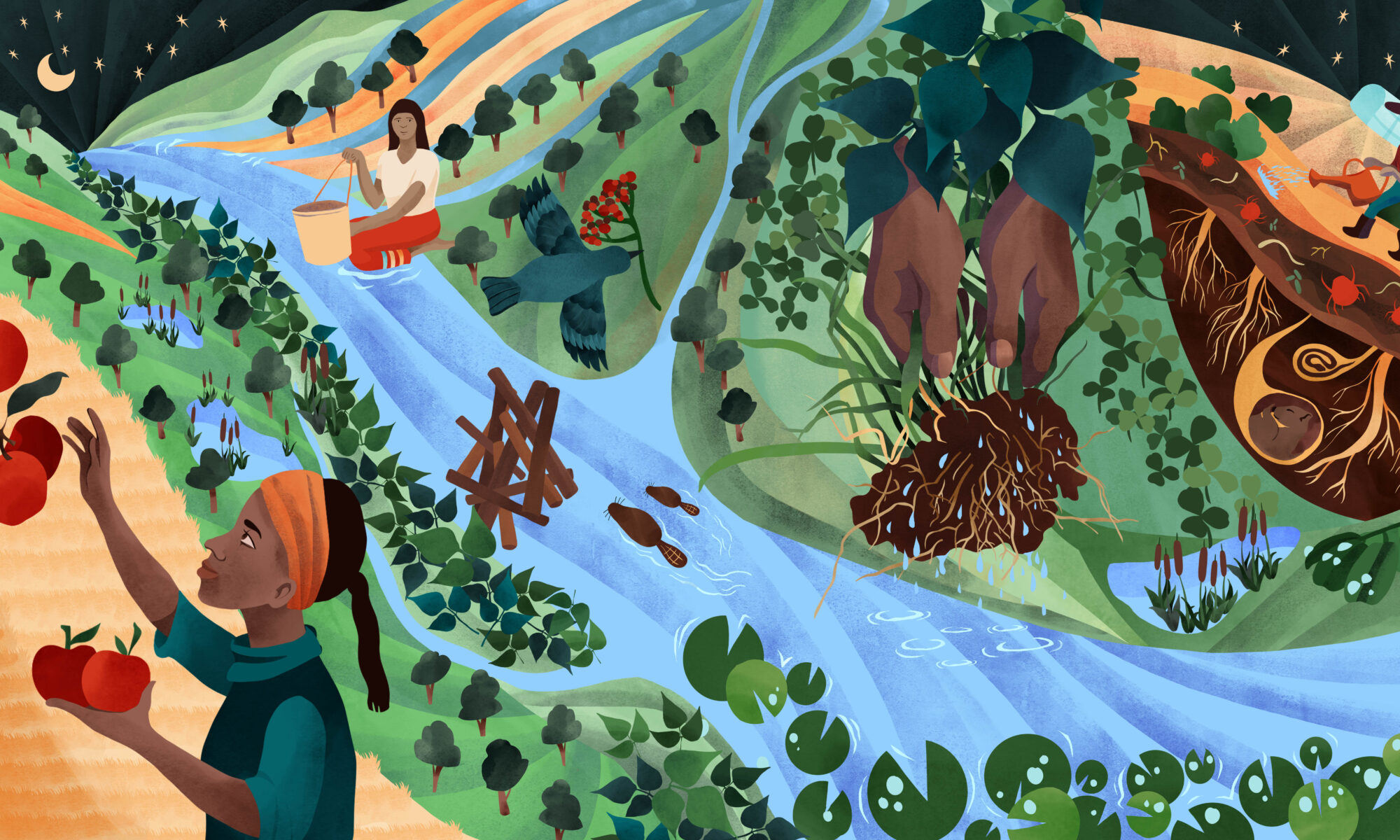Cover illustration by Garth Laidlaw and Jenna Kessler.
Our planet is 70% water. Earth is a unique planet because we have liquid water. Many Indigenous peoples say that Water IS Life. Microbiologists speculate that life on land began when algae teamed up with fungi to create lichen. Lichen dissolves rocks, which was the first step in creating soil. With soil, all the rest of the plants evolved. Plants, soil and water form the nexus through which life on land can survive and flourish.
Green plants, through the process of photosynthesis, drive both the carbon cycle and the water cycle. The part of the water cycle that happens on land is sometimes called “green water”, because it refers to the water which flows through plants. Plants draw water from inside the earth, pulling it up through their roots and releasing it through the stomata on their leaves where the liquid water converts to water vapor. As water changes phase from liquid to gas, it uses the sun’s energy to convert sensible heat (the heat we can feel) into latent heat. Water vapor rises up into the atmosphere, forming clouds and eventually, as it reaches the cooler temperatures of the upper atmosphere, it will condense to turn back into liquid water, releasing this latent heat energy away from the surface of the earth. Thus, the evapotranspiration of plants removes heat from the land surface and also enables the formation of clouds and rain. Any land which is barren of plants will lose its water and become more hot and dry. Michal Kravcik, co-author of The New Water Paradigm, says that this process of evapotranspiration moderated by plants is Earth’s air conditioning system.

We say that climate change is caused by a buildup of greenhouse gasses in the atmosphere, causing it to retain more heat, but perhaps there is another factor which exacerbates this. When we look at climate change phenomena, we see disruptions to the water cycle. Climate change manifests as long dry periods without rain, causing droughts and wildfires, punctuated by violent winds and storms leading to flooding. Both the wet and the dry periods erode our soils, baking them in the heat until we lose the soil structure and then washing away the organic matter as floods carry it away into the waterways. A lot of this damage is caused by human intervention in the landscape. We drain water, we clear the land, we remove the trees and we bore into the groundwater reserves to sustain our insatiable need for water.
Zach Weiss, an ecosystem restoration practitioner and educator, calls this ‘’the watershed death spiral.’’ Bare soils and hard packed surfaces retain heat and shed water. If water doesn’t penetrate into the earth, it doesn’t feed the groundwater reserves, which perpetuates a cycle of increasing dryness and loss of soil structure. As the ground gets drier, we resort to irrigation and perpetuate this cycle by draining rivers, digging wells and increasingly depleting the groundwater. Zach and his colleagues at Water Stories are educating and showcasing water restoration practitioners, applying simple principles in order to create water retention landscapes. These methods can be used anywhere in the world to restore fertility and bring back the green water cycle. The basic principle is to retain every drop of rain that falls on the land and store it in the landscape. Water can be stored in the form of ponds, healthy deep soil, vegetation or underground aquifers.

What is the cause of these extremes between too wet and too dry? The common explanation is that there is more water vapor in the atmosphere because the global temperatures are warmer. But according to Professor Millán Millán, a Spanish meteorologist and climate scientist, land use change can play a big part in the frequency and timing of rain events. He was mandated by the Commission of the European Union to look into why summer storms stopped in the Mediterranean Basin. Historically water vapor from the Mediterranean Sea blew over the land and as it rose up the sloped land around the Mediterranean Basin it would frequently rain on summer afternoons. But this stopped happening and gradually the region received no more rain in the summertime.
What Professor Millán found was that due to the removal of vegetative cover in the region, the moist air which blew off the sea, heated and dried as it moved over the land. By the time it rose up the slopes, it no longer contained enough moisture to condense as rainfall. Historically, the evapotranspiration of sea marshes and forest on the slopes would add to the moisture coming from the sea, making the critical difference to trigger rain. Instead of releasing the sea’s moisture over the land, the air returned back down the slope and began to accumulate as layers of moisture over the sea. Eventually, the accumulated moisture which did not fall there will be released. In the fall or late summer as land temperatures decrease, this huge volume of accumulated moisture will be blown back over the land, but maybe not in the same place. Sometimes this has been the cause of huge flooding events in northern Europe.
Professor Millán says he sees this vicious cycle he identified in the Mediterranean area happening in many other parts of the world. It starts with clearing vegetation from the landscape. The land then accumulates more heat and becomes drier. The soil moisture evaporates. There is less evapotranspiration adding its contribution to the moisture coming in from the air, so there are less clouds and rain. The soil structure is lost as soil life needs moisture and vegetative cover. Soil becomes hydrophobic. When rains do come, they run off the surface causing erosion and sometimes mudslides. Once soil is lost, it is much harder to reverse the damage. This is the cycle of desertification that Zach Weiss refers to when he talks about the watershed death spiral.
Industrial agriculture, urbanization, logging and mining are systematically reducing vegetative cover around the world. Our groundwater reserves are being depleted everywhere. There is a finite amount of water in the world but how it is distributed makes a huge difference. When our fresh water leaves the land it is hard to get it back. If we want to keep life on land, we need to restore healthy soils and vegetative covering. Let’s keep more water in the landscape.
Happy World Water Day! Raise a glass, and give a sip back to the ground! Here’s to getting smarter about managing our soils and water.
Want to learn more about the role of soil in hydrating landscapes to mitigate climate change? Watch recordings of the 2021 Living Soils Symposium on our Media Library!




